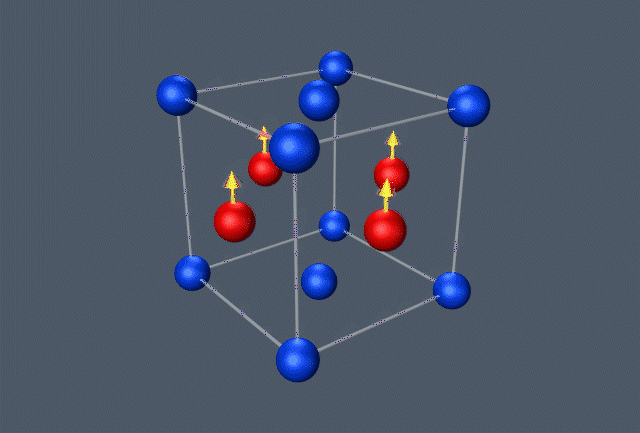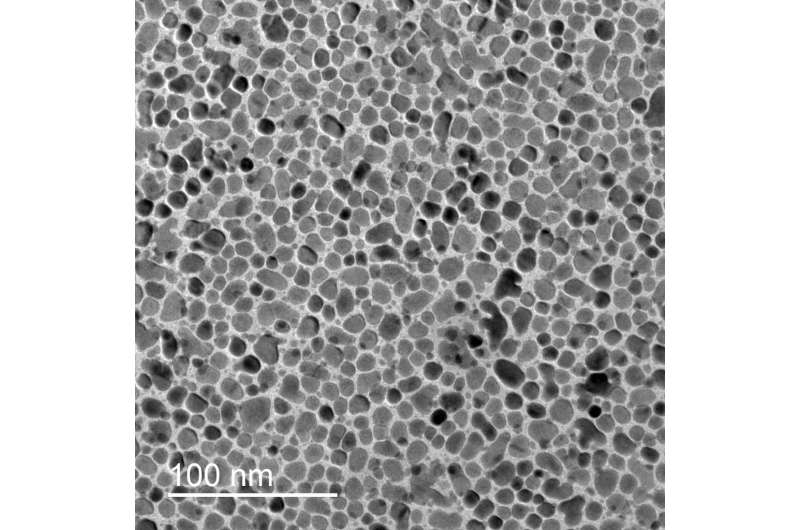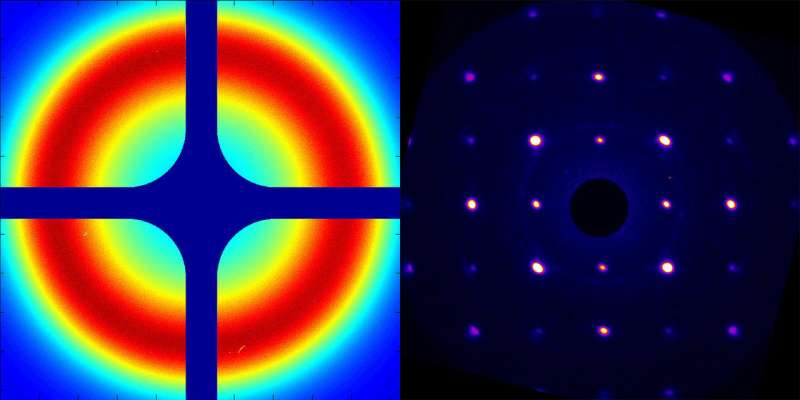Illustration of the rapid atomic response of iron-platinum nanoparticles to laser light. Iron atoms are shown in red, platinum atoms in blue. A brief flash of red laser light demagnetizes the sample (transition from aligned arrows to random arrow orientation). This leads to a compression of the atomic structure in one direction and an expansion in another. Credit: Greg Stewart/SLAC National Accelerator Laboratory
Scientists at the Department of Energy's SLAC National Accelerator Laboratory have seen for the first time how atoms in iron-platinum nanoparticles – a next-generation material for magnetic data storage devices – respond extremely rapidly to brief laser flashes. Understanding these fundamental motions could potentially lead to new ways of manipulating and controlling such devices with light.
Combining snapshots from two world-leading ultrafast atomic-resolution "cameras" at SLAC – the Linac Coherent Light Source (LCLS) X-ray laser and an apparatus for ultrafast electron diffraction (UED) – the team showed that the laser flashes demagnetized the iron-platinum particles within less than a trillionth of a second, causing atoms in the material to move closer together in one direction and move further apart in another.
The results also provide the first atomic-level description of the mechanical strain, known as magnetostriction, occurring in magnetic materials when the magnetization is changed. The phenomenon manifests itself in many ways, including the electric hum of transformers. Before the study, published today in Nature Communications, researchers had assumed that these structural changes happen relatively slowly. However, the new data suggest that ultrafast processes could play an important role.
"Previous models of the properties of iron-platinum nanoparticles did not consider these extremely fast and fundamental atomic motions," says Hermann Dürr, the study's principal investigator from the Stanford Institute for Materials and Energy Sciences (SIMES), which is jointly operated by SLAC and Stanford. "Although we don't yet understand the full ramifications of these processes, including them in our calculations could open up new pathways for the development of future data storage technologies."
Image of iron-platinum nanoparticles taken with a scanning transmission electron microscope. Credit: Tyler Chase/Stanford/SLAC National Accelerator Laboratory
Pushing the Limits of Magnetic Data Storage
Magnetic storage devices are widely used to record information produced in virtually all areas of our digital world, and they are believed to remain crucial data storage solutions for the foreseeable future. Faced with ever growing amounts of global data volumes, hardware engineers are aiming to maximize the density with which these media can store information.
However, current technologies are coming close to their technical limits. Today's hard disk drives, for example, can reach storage densities of several hundred billion bits per square inch, and similar future devices aren't expected to exceed much more than a trillion bits per square inch. New developments are required to take magnetic data storage to the next level.
Intensity pattern on a detector created by X-rays (left) and electrons that have passed through a sample of iron-platinum nanoparticles. The X-ray data reveal information about the sample’s magnetic state, and the electron data provide details of the atomic structure. Credit: Alexander Reid/SLAC National Accelerator Laboratory
"A very promising approach that could take us there is heat-assisted magnetic recording in hard drives using nanosized grains of materials like iron-platinum," says Eric Fullerton, director of the Center for Memory and Recording Research at the University of California, San Diego, and a co-author of the new study. "In this method, the information is encoded with a nanofocused laser and a magnetic field, or possibly even a laser alone, that switch the magnetization of the nanoparticles. These next-generation drives, which can have much larger storage densities, are already being tested in industry and could soon become commercially available."
More information: Beyond a phenomenological description of magnetostriction. Nature Communications. DOI: 10.1038/s41467-017-02730-7
Journal information: Nature Communications
Provided by SLAC National Accelerator Laboratory

























